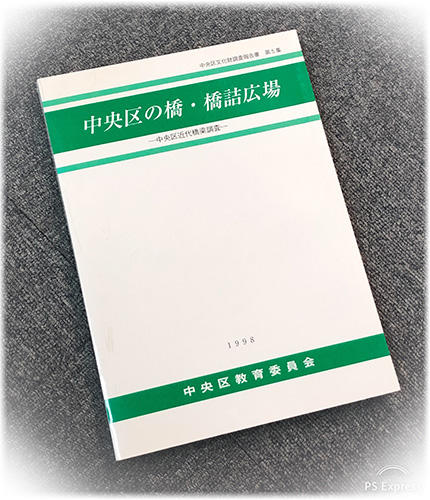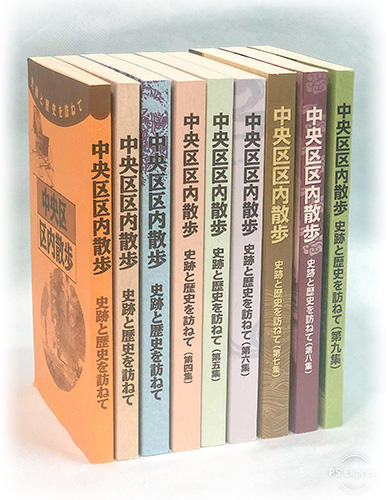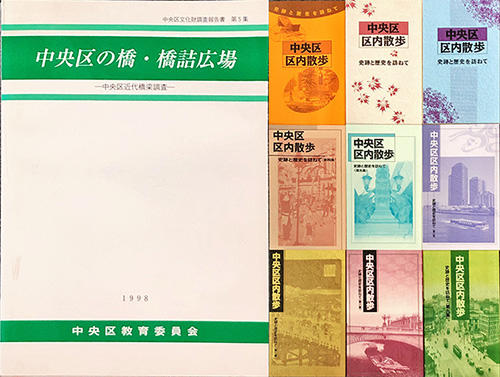![]() The other day, I got two books published by Chuo-ku, so I will introduce them.
The other day, I got two books published by Chuo-ku, so I will introduce them.
1."Bridge of Chuo-ku, Hashizume Plaza-Chuo-ku Modern Bridge Survey-"
(Edited and issued by the Chuo-ku Board of Education in 1998 / ¥1,900 (at the time of issuance))

![]() I've written on this blog before, but I, May Rain George likes an unrivaled bridge. The spiritual man says that my ancestors were bridge craftsmen (surveying and design).
I've written on this blog before, but I, May Rain George likes an unrivaled bridge. The spiritual man says that my ancestors were bridge craftsmen (surveying and design).
※A previous bridge-related article
/archive/2017/07/post-4453.html (Street of Bridge)
/archive/2017/05/-2322270.html (about the bridge and its name)
![]() "Chuo-ku Bridge / Hashizume Plaza-Chuo-ku Modern Bridge Survey-" was shown by the owner of a long-established restaurant acquaintance in Ningyocho. When I contacted the ward office, it was already out of print. I really wanted it, so I found it online. Somethings in a very good condition were available cheaply.
"Chuo-ku Bridge / Hashizume Plaza-Chuo-ku Modern Bridge Survey-" was shown by the owner of a long-established restaurant acquaintance in Ningyocho. When I contacted the ward office, it was already out of print. I really wanted it, so I found it online. Somethings in a very good condition were available cheaply.
▲At the time of publication, it was introduced in the Asahi Shimbun.
![]() As described in the "Chuo-ku Cultural Properties Survey Report Vol. 5", this report investigates all bridges in Chuo-ku from a professional standpoint of modern bridges built from the Meiji era to the early Showa era. It is.
As described in the "Chuo-ku Cultural Properties Survey Report Vol. 5", this report investigates all bridges in Chuo-ku from a professional standpoint of modern bridges built from the Meiji era to the early Showa era. It is.![]() The contents are broadly divided into <Part 1 length / analysis> <Part 2 ledger> and <Part 3 material>. In the first part, we analyze bridges in Chuo-ku from various perspectives, such as time-specific, bridge design characteristics, earthquake disaster and reconstruction. The second part summarizes the history, characteristics, and design of all bridges across each river, along with photographs and drawings. Part 3 summarizes the date of groundbreaking and completion, length, width, format, construction cost, etc. in a list.
The contents are broadly divided into <Part 1 length / analysis> <Part 2 ledger> and <Part 3 material>. In the first part, we analyze bridges in Chuo-ku from various perspectives, such as time-specific, bridge design characteristics, earthquake disaster and reconstruction. The second part summarizes the history, characteristics, and design of all bridges across each river, along with photographs and drawings. Part 3 summarizes the date of groundbreaking and completion, length, width, format, construction cost, etc. in a list.
This report on about 360 pages, including A4 size and color pages, contains photographs of the bridge that are currently reclaimed by the river and only the name of the bridge remains, and photographs of the bridge before it was newly rebuilt and its surroundings. I think that it has increased its presence as a valuable historical material.
▲Armor Bridge page
▲Chiyodabashi and Shinbabashi pages

▲Shipping Bridge (Kaedegawa) ▲Former Shinohashi (Sumida River)

▲Mihara Bridge (Sansanmabori) ▲Sukiya Bridge (outer moat)
2."Walking in Chuo Ward---Visit Historic Sites and History-" 9 books
(Edited and published by the Public Relations Office, Chuo-ku Planning Department)
![]() The second book is "Walking in Chuo Ward--Visit Historic Sites and History-". This is a new book version of the "Walking in the Ward", which was serialized in the public relations paper of Chuo-ku from 1985 to 2010, which has been further enhanced. After the first volume was published in 1988, it was published in the world every few years, two and three volumes, and completed in 2013 by the publication of the ninth volume (final volume).
The second book is "Walking in Chuo Ward--Visit Historic Sites and History-". This is a new book version of the "Walking in the Ward", which was serialized in the public relations paper of Chuo-ku from 1985 to 2010, which has been further enhanced. After the first volume was published in 1988, it was published in the world every few years, two and three volumes, and completed in 2013 by the publication of the ninth volume (final volume).
![]() It is "Chuo Mayor" that writes "First" at the beginning of each book, but I also respect that Mr. Hidehide Yada has been serving as mayor by himself for the past 25 years of publication of these nine books. I want to show it.
It is "Chuo Mayor" that writes "First" at the beginning of each book, but I also respect that Mr. Hidehide Yada has been serving as mayor by himself for the past 25 years of publication of these nine books. I want to show it.

▲"Walking in Chuo Ward"
![]() This is still on sale and can be purchased at the Information Disclosure Corner on the first floor of the Chuo-ku Ward Office (9 totals ¥ 4,730). I am not from Chuo-ku and do not live or live, but every time I turn the page, there are new discoveries, fun and very study.
This is still on sale and can be purchased at the Information Disclosure Corner on the first floor of the Chuo-ku Ward Office (9 totals ¥ 4,730). I am not from Chuo-ku and do not live or live, but every time I turn the page, there are new discoveries, fun and very study.
![]() The contents of each volume are as follows. (Each volume is about 160 to 260 pages.)
The contents of each volume are as follows. (Each volume is about 160 to 260 pages.)
Volume 1 (500 yen) “One year in downtown”, “Cityscape”, “Living”, “Civilization and enlightenment”, “Literature Path”
Volume 2 (500 yen) "Kyomi of the Four Seasons", "Memor of Edo", "Toward modernization", "Food of Culture", "Bridge and Liveliness"
Volume 3 (500 yen) "Around Monuments and Cultural Properties", "Civilization and enlightenment Urabananashi", "Kaori of Arts and Culture", "Metales of the City", "Life of Citizens" and "Dietary Life"
Volume 4 (500 yen) "Become a town of Edo", "Brightness of Edo culture", "Ashidori of Kaika", "Original scenery of modern literary arts", "Activity of women", "Understanding town"
Volume 5 (400 yen) "Edo-fetal movement to modern times", "Encounter with foreign countries", "Theatrical protagonists", "The World of Literary", "City-Flowing Memory", "Memory Arata"
Volume 6 (400 yen) "Start to modern times", "Photographers of Kaikai", "Literature born by Nihonbashi", "People around Kaikaikan", "People of Kaikai", "Kafu Nagai and Chuo-ku", "Tsukiji Small Theater"
Volume 7 (600 yen) "Chuo-ku Haiku Group Statue", "Freedom Baron Satsuma Satsuma Jirohachi", "Playwright Torahiko Koori who died in Western Europe", "People living in water"
Volume 8 (700 yen) "Nihonbashi", "Yumeji Eternal Woman Hikono Kasai", "Sumida River Water Range", "Chuo-ku Seen by Foreigners", "Tsukiji 350 Years"
Volume 9 (630 yen) "Chuo-ku seen by foreigners", "Ginza in the early Showa era", "Ginza during the war"


